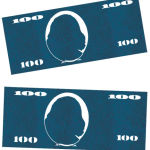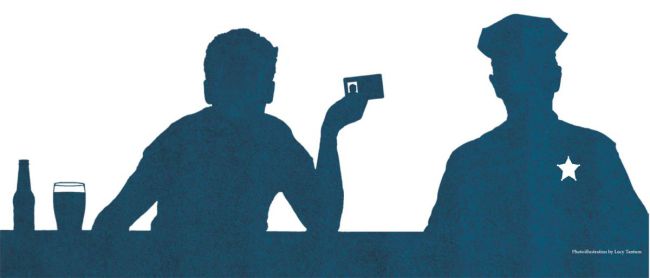The supply: How, why, and by whom fake IDs are created
Senior “Johanna” describes herself as innocent and unsuspecting. She also prides herself on her ability to talk.
A slight, outspoken girl, Johanna seems to be no one out of the ordinary. She spends her time juggling school, sports, and friends.
But when she received a text from a former Redwood student last November asking if she wanted to sell fake IDs to her peers, she agreed. She had seen him do it countless times before, so she felt no fear about potential repercussions.
“I’m probably the least suspecting person,” Johanna said. “The first thing I thought was that it would be fun.”
Johanna said she has sold about 30 IDs, and it is clear that she has maintained the fearlessness that she possessed from the start.
“I’m under 18, so honestly they can’t do anything,” she said. “I mean, they could do something, but I’m not important enough that they would charge me as an adult.”
Her perceived safety net comes from her role in the business. Johanna is simply a middle the man; she is the first contact for potential customers and stays as far away from the manufacturing process as she can.
While her actual tasks model those of a messenger, what makes the job difficult is maintaining her anonymity and recognizing the looming possibility of getting caught.
“If we ever talk about it, we never use our real accounts, and all of our documents are locked,” Johanna said. “For me, it’s really such a simple process, all I have to do is talk to people.”
She doesn’t even have to seek people out, according to Johanna. After she initially made herself known among a few friends, people started coming to her instead of the other way around.
However, the process is not as simple as she makes it sound.
When Johanna is first approached by a potential buyer, she immediately gives them alternate contact information. She has a phone number and numerous email accounts designated specifically for the job.

She has several emails through which her customers can contact her, none of whom are supposed to use her real name when talking about business deals.
In order to make an ID she asks for five pieces of essential information–a name, a birthdate, a real address, a signature, and photo identification.
Once she receives that information from buyers, she forwards it to the guy who makes the IDs out of San Rafael. According to Johanna, the printers they use are ordered from China, because it is illegal to sell them in the U.S.
In order to get the ID’s to scan, the company has a contact who can create a barcode that will scan through the DMV system. This person creates the barcode with the information originally given to Johanna.
The final step in her process is delivering the finished product.
“We never meet at my house or their house,” Johanna said immediately. “We meet in a neutral location.”
While Johanna doesn’t think the risk factor is particularly high for her right now due to her age, she knows that things will change once she turns 18.
“It’s something that I’ve been thinking about lately,” she said. “On one hand, the demand for IDs goes way up in college, but I could also get in way more trouble once I turn 18. Things get way more serious.”
California law states that producing or selling a fake ID is a misdemeanor and can lead to a $1,000 fine and a minimum of 24 hours of community service.
Surprisingly, selling or manufacturing fake IDs is often a crime with a smaller penalty than possessing and using an ID according to Central Marin Police Officer Aaron Damm.
For now, the excitement of the job, the fact that she is still a minor, and the money she recieves from it makes the current risk worth it.
“I have to give the guys a flat rate, and I keep anything after that,” she said. “I get to make my own prices.”
Johanna didn’t want to reveal what price she charges because they fluctuate.
“For my friends obviously I charge less,” she added. “And after that, the bigger the group of people lower the price.”
However, she did not shy away from admitting that she does make a sizeable profit.
“I have to charge enough,” she said. “So basically, I get to decide what I charge and how much I make. I’m not going to tell you how much I charge because then people will think I make too much money.”
The demand: Teens utilize fake IDs despite possible risks
As Gavin approaches the door of the San Francisco club, the familiar nervous jitters settle in. He subtly reaches into his drawstring bag and fumbles around for his wallet, grabbing his California driver’s license and dropping it to the bottom of the bag.
As the line diminishes, the nerves are overtaken by a sense of confidence. When he gets to the front of the line, he wordlessly flips open his wallet to reveal a Texas ID. The bouncer glances it over once and waves him in.
“Gavin,” a senior who wished to remain anonymous, said the key to using a fake ID is confidence.
According to a study done by Julia Martinez, a psychology professor at Colgate University, one in eight pre-college students have fake IDs.
“If you dress the part and just look like you couldn’t care less, they usually don’t question a fake ID,” he said. “A real 21-year-old isn’t nervous to show their ID at the door.”

Gavin, who got his ID during the summer before his senior year, said he got it after his older sibling mentioned the idea to him.
“My brother got a group together and just asked me if I wanted to get in on it,” he said. “I thought, ‘Why not?’ If I don’t have to do the work to find someone, of course I want one.”
For the first six months of having his new ID, Gavin said he kept it a secret from his friends at Redwood.
He used it to get into Bay Area clubs and wineries with friends, and to go places when he visited his brother at college.
“I’ve used it in the city a few different times and one time I went up to Sonoma with a few friends,” he said. “I’ve noticed that classier places just don’t care as much. If they’re getting more money from you, they don’t tend to care as much, whereas places that are cheaper that teenagers would want to go to more, like certain clubs and buying up especially, they’ve been more careful with me.”
According to Central Marin Police Officer Aaron Damm, minors charged with possessing a fake ID are considered “wobbler” cases, meaning that the crime can be charged as a felony or a misdemeanor. He added that the charges for possessing a fake ID vary with age, reason of use, and any existing criminal records.
Damm said that when he encounters minors with fake IDs he immediately calls their parents and confiscates the ID so that it can be taken into evidence. Depending on the time of day, Damm added, the department may also contact school officials.
As time has passed, Gavin said he has found it harder to keep his ID a secret from his friends. He said that as they’ve found out, they have been asking him to “buy up,” meaning buying alcohol for his peers who do not have fake IDs.
“In the last couple months I’ve had several people approach me and I told them I lost it. I’ve been totally fine trying to get into bars and clubs,” he said. “I went to visit schools with my brother and we were using it and it was totally fine. We were both using our fakes from different states and and it was fine. But buying up is different.”
“Peyton,” a senior who does not have a fake ID, said she asks her peers with fake IDs to get her alcohol when she goes out.
“Buying up is always scary,” she said. “I’ve had a few people do it for me, but now I only feel comfortable with this one person.”
Peyton said once she found someone she was comfortable with, it was easy for her to get in contact with her and meet up.
“We usually meet right before I need some,” she said. “But I’m careful to not overuse her and make her frustrated.”
According to Damm, minors who “buy up” can be charged with the crime of contributing to the delinquency of a minor.
Unlike Gavin, anonymous senior “Johanna’s” first encounter with fake ID’s came when she bought herself one her junior year.
She said wanted to have the freedom that comes with being a few years older.
“I don’t drink that much during the school year,” she said. “But even just being over 18 brought so much freedom. I had older friends and it was way easier to be able to go places with them even though I didn’t usually drink.”







